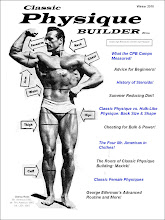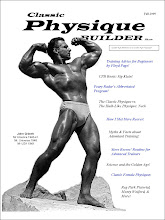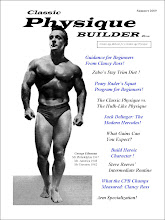 Take a look at Jack Delinger (Mr Western America 1948, Mr America 1949, Mr Universe 1956) above. He was a champion of the pre-steroid Golden Age of Classic Physique Building. He (and the other champions you see here at CPB) is a shining example that it is possible to build classic mass without resorting to health-destroying drugs. In fact, during the height of the Golden Age (between 1950-59), the principles of building mass naturally were defined. These principles worked then and still work now! We will discuss them in this and other upcoming posts.
Take a look at Jack Delinger (Mr Western America 1948, Mr America 1949, Mr Universe 1956) above. He was a champion of the pre-steroid Golden Age of Classic Physique Building. He (and the other champions you see here at CPB) is a shining example that it is possible to build classic mass without resorting to health-destroying drugs. In fact, during the height of the Golden Age (between 1950-59), the principles of building mass naturally were defined. These principles worked then and still work now! We will discuss them in this and other upcoming posts. To understand some of these principles, let's take a look at Joe Weider's classic "Power and Bulk Routine" from 1954. Here are the exercises:
1. Shoulder Bridge (it was like a decline bench press)
2. Cheating Barbell Curl
3. Deadlift Off Boxes
4. Cheating Standing Lateral Raise
5. Bench Squat
6. Cheating Standing Triceps Barbell Curl
7. Cheating Bent Over Rows
8. Power Prone Press (this is basically a bench press lock-out)
Each exercise was to be performed for 2 sets of 6 reps only. The emphasis was on using heavy weights such that you could barely complete the 6th rep of the 1st set. Then after resting for 2 minutes, you might be able to complete 4-5 reps on the second set (going to failure). After a workout or two, once you could complete the 6th rep of the 2nd set, then you would increase the weight at the next workout. This process would continue as you strive to keep pushing up the weight used as you get stronger. This workout was to be done 3 days a week (e.g., M, W, and F) and all other sports activity was to be avoided. Also, getting more rest, more sleep, and eating a high protein diet was recommended. This program was to be followed for 3 months.
So what are the principles we see in this program? We can't discuss them all in this post, but here is a partial list:
1) full body workout - doing a full body workout, which includes testosterone-releasing exercises like squats and deadlifts, has a global anabolic
2) low volume, high intensity - using only a few sets (low volume), yet training to failure (high intensity) allows maximum muscle stimulation without overtraining
3) training heavy - training for power/strength stimulates a greater number of muscle fibers which results in greater muscle growth
4) cheating exercises - using a cheating style allows heavier poundages for greater muscle stimulation
5) lock-out exercises - doing a "lock-up" (just doing the last few inches of an exercise) allow much heavier poundages to be used which results in greater muscle stimulation
6) no cardio - avoids unnecessary drain on body's recuperative powers, thus more resources are channeled into muscle growth
7) compound exercises - stimulate more muscles than isolation exercises and allow for heavier poundages to be used
8) no abdominal work - diet is the key to great abdominals, not exercise
9) longer rest between sets - allows more muscle recovery which allows heavier weights to be used
10) progressive resistance (overload) - increasing the weights as muscles get stronger is key in stimulating continued muscle growth.
Compare this program to the one you are using! Are you performing a lot of reps with lighter weights? Are you following a split program and are in the gym everyday? Do you do a lot of isolation exercises and tend to use the same poundages each workout? Do you simply stop at a set number of repetitions or do you train to failure (or almost failure)? Does your exercise program consist of more than 8 exercises? Have you been doing more and more sets, but not gaining any mass? If so, then study the principles above and apply them to your routine if you want to gain mass.
In the Golden Age of Classic Physique Building, they really knew, from their own experience, what was needed to build mass! And they could do it without drugs and even without all the high-tech nutritional supplements we have today. What supplements did they have? Try this: protein powder and multivitamins! That was about it! Yet, they perfected the art of building powerful, heroic, classic physiques by discovering the principles that really work - naturally!
This should give us a lot of encouragement! You can build all the mass you need for a classic physique. The champions of the Golden Age have already laid out the path for us. All we have to do is re-discover that path and follow it! - CPB







2 comments:
What is lock-out exercises? Is partials movements?
Hi Anonymous,
Yes...a "lock out" exercises is a partial movement where you are just doing the movement over the last part of its full range up to the lockout (finished position).
For example, for the bench press, if you do it on a Smith machine (or equivalent), you can position the bar and locks so that your rep only covers the last 6-12 inches of the movement (in other words, it covers a small range just before the lock-out). In this range, your muscles are much stronger and can handle much more weight than in the beginning position (when the bar is at your chest).
So for a lock-out exercise, like the bench press lockouts, you can load up the bar with much more weight than you could handle doing a full-range bench press. This added weight stimulates muscle fibers in a different way - a way not stimulated if you were using lighter weights over the full range of a bench press. This new stimulation can result in new growth and increased strength.
I hope this helps!
CPB (Anthony)
Post a Comment